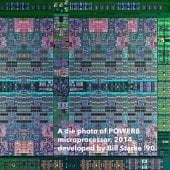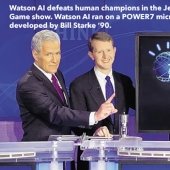For me at MTU, it was always about the hardware. I used my technical electives to
build the equivalent of a computer engineering minor along with my CS degree. Upon
graduating in 1990, I landed a job with IBM (Poughkeepsie, NY) writing performance
simulators (along with specialized high level HDL’s, tracing tools, and visualization
tools) for evaluating processor pipelines, cache hierarchies, and SMP structures for
IBM’s mainframes. Early on I was surrounded by brilliant “old-timers” in development
and research (even an ancient IBM Fellow who had once worked as John Von-Neumann’s
lab director). During those first few years I was a sponge, learning many things about
weighing trade-offs on the “what-should-be’s” of advanced processor architectures.
But after a few years, the mainframe died. Or so the pundits said. Massive lay-offs,
restructuring, a new CEO, and a diaspora of remaining talent to other parts of IBM.
Fast forward a few years and I got the opportunity to move to Austin, TX, in a new
organization bridging mainframe know-how with the growing new world of RISC processing
(IBM’s “Power” architecture). IBM was coming back and the mainframe was stabilizing.
But RISC was the new kid in town and the dot-com boom was happening there. IBM’s CEO
made a big bet, pushing Power RISC to the center of IBM’s e-business strategy. Several
competing Power processor projects got killed to consolidate to a new one: POWER4.
I was in the right place at the right time, as a processor performance architect,
driving and evaluating the ideas that formed the basis for POWER4.
Somewhere in the middle of POWER4 development, a few top architects who had taken
notice of me, pulled me out of my performance role to work directly in the microarchitecture/logic
area. This was no longer “what-should-be”. It was: how do you make “what-should-be”
a reality. Invent the hardware algorithms. Get them to functionally work. Get them
to be physically realizable in silicon. Understand all the economics of balancing
the constraints. Somehow, they forgot I was a computer scientist, not an engineer.
But I’ve always felt MTU prepared me for a broader set of challenges than just the
typical computer science stuff.
At this point in my career, I was already an established veteran in the performance
role, so taking on this new challenge was a huge risk. It paid off handsomely. By
combining expertise in “what-should-be” with expertise in the economics of making
“what-should-be” a reality, I rose to the top. By the time we built POWER6 (2002-2007),
I was chief architect for the whole SMP cache hierarchy, memory and I/O subsystems,
and chipset/system structure for IBM’s Power server processors. Working through my
team of 10 to 15 architect specialists and numerous execution leads and project managers,
I was directing the work of hundreds of people across several development sites.
By 2012 I was promoted to Distinguished Engineer, a nod to the accomplishments of
the prior decade. In 2016, I took my turn as the overall chip architect for the Power10
processor, adding processor core and management functions to my more localized scope
of expertise, and tripling the number of people I was directing. We released Power10
processors and systems in 2021, finishing them up during the pandemic, which added
a whole new kind of strain. I am still in the overall chip architect role for the
follow-ons to Power10 that are currently in development.
Summing it up, during my career, early on, I made minor contributions to some early
1990’s mainframes and the POWER3 RISC processor. Later, I made major contributions
to POWER4 and POWER5. Then I was chief architect for cache, SMP, memory, and I/O systems
for POWER6, POWER7, POWER8, and POWER9; and overall chief architect for Power10 (silly
branding change went from upper case “POWER” to lower case “Power”). Through collaborations
with my counterparts in mainframe development, I’ve also made minor contributions
to several more recent mainframes, most recently Z16. Power systems and mainframe
systems are used behind the scenes for mission critical finance, insurance, medical,
retail, logistics, manufacturing, and government operations. Almost all the large
“household name” companies that people do business with, rely on Power systems for
their mission critical applications. Power supports three operating environments:
AIX (IBM’s high value UNIX), Linux, and IBM i (formerly known as AS/400, which evolved
from the S/38 and S/36 minicomputer platforms).
I’ve haven’t even touched on many of the adventures I’ve had while working on all
those processors: calling out VLIW as a dud before Intel and HP even started pursuing
the Itanium VLIW architecture; deep collaborations with Japanese engineers from Hitachi;
creating a specialized supercomputer for the DoD (it seemed like we were living a
science fiction novel); working with game console processors when IBM built them for
Playstation, Xbox, and Wii; building the computer that beat human Jeopardy game show
champions; partnering with Google, NVIDIA, Mellanox, Micron, and many more on numerous
hardware innovations; building the Summit and Sierra supercomputers (#1 and #2 on
the top 500 list); creating new memory and composability architectures; traveling
throughout the U.S., Europe, and east Asia, speaking at client conferences, launch
events, and training sessions. Any of these could be the basis for many more stories.
I feel very fortunate and I’d be nowhere without the great education I got at MTU,
education from mentors at IBM, and the opportunity to work with so many brilliant,
motivated, and kind teammates in IBM. As a student, this was the dream job I never
believed could be possible, then somehow it happened to me.



